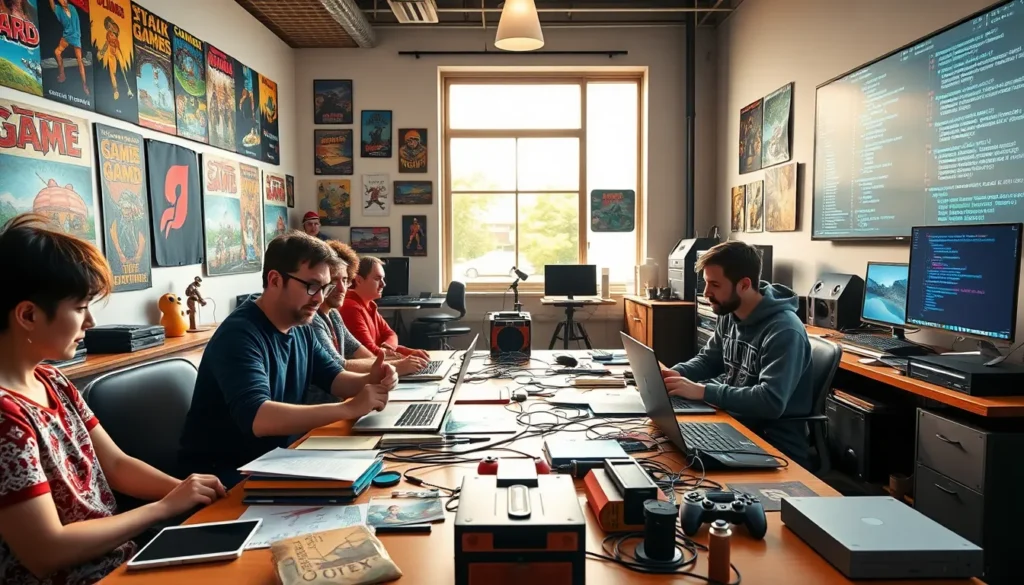Table of Contents
ToggleGame development is a dynamic field that continuously evolves, driven by technological advancements, changing player preferences, and creative innovations. Within the vast landscape of this industry, the “RamblingsOfAGamer Archives” stands out, offering a wealth of insights, experiences, and knowledge. This article delves into the core components of game development, examines key trends shaping the industry, shares personal insights from the archives, and highlights the impact of community feedback on game evolution.
Overview of Game Development

Game development encompasses a variety of disciplines, including design, programming, art, and sound. It is the process of creating video games, from initial conception through to final release and post-launch updates. The industry is characterized by its collaborative nature, as developers, artists, writers, and sound designers work in tandem to bring a game to life.
Historically, game development began as a niche pastime in the 1970s and has transformed into a multi-billion-dollar industry. The rise of personal computers and gaming consoles paved the way for more sophisticated games and dedicated teams. Currently, the development process can vary greatly depending on the scale of the project: indie developers might work alone or in small teams, while larger studios boast hundreds of employees working under tight deadlines.
Key Trends in Game Development
In recent years, several key trends have emerged in the game development industry. These trends not only reflect the changing gaming landscape but also signal where the industry is headed in the future.
1. Emphasis on Cross-Platform Play
One significant trend is the push for cross-platform play, allowing gamers on different consoles and PCs to play together. This inclusive approach has been driven by titles like “Fortnite” and “Rocket League,” which have successfully bridged previously siloed gaming communities.
2. Adoption of Cloud Gaming
Cloud gaming has gained traction as a viable alternative to traditional console and PC setups. Services like Google Stadia and Nvidia GeForce Now enable gamers to stream games without the need for expensive hardware, making high-quality gaming more accessible.
3. Focus on Diversity and Inclusion
There is a growing awareness about the importance of diversity and inclusion in games. Developers are increasingly focused on representing diverse characters and narratives, ensuring that players from all backgrounds feel seen and valued.
4. Rise of Indie’s Influence
Indie games continue to flourish, often leading innovation and creativity while challenging conventional gaming norms. Titles such as “Hades” and “Celeste” show how indie developers can make a significant impact without the resources of large studios.
Personal Insights from RamblingsOfAGamer
The “RamblingsOfAGamer” archives encapsulate a range of personal insights from both independent developers and industry veterans. One of the most striking elements featured in these ramblings is the emphasis on creativity and experimentation in game design.
Developers within the archives often express the value of prototyping and testing new gameplay mechanics, encouraging fellow developers to embrace failure as a learning opportunity. For example, one developer recounts how a seemingly disastrous failure during a game jam eventually led to the creation of a beloved title due to the unique design element they discovered.
Also, the archive underscores the significance of storytelling in games. Modern players are seeking more profound narratives and character development, and many developers emphasize the necessity of putting player experience at the core of design choices. This focus transforms gameplay from mere entertainment into immersive stories that resonate with the audience.
Impact of Community Feedback
Community feedback plays a pivotal role in shaping game development today. Engaging players during the development phase, through alpha and beta testing, has become a norm rather than an exception. Feedback loops allow developers to refine their games based on player interactions, creating a sense of ownership among gamers.
Case Studies from the Archives
The archives contain invaluable case studies demonstrating the success of incorporating community feedback. For instance, a popular case is that of “No Man’s Sky,” which faced immense backlash upon its release due to unmet expectations. The developers embraced this feedback, actively implemented changes, and eventually transformed the game into an award-winning title by continuing to iterate based on community suggestions.
Another noteworthy example is the game “Stardew Valley,” which benefited greatly from the input of its player community, allowing for thoughtful enhancements that enriched the gaming experience. These examples illuminate how listening to the community can lead to remarkable game evolution and increased player satisfaction.
Conclusion
The “Game Development RamblingsOfAGamer Archives” provide a treasure trove of insights into the evolving landscape of game development. By examining the current trends, personal reflections from developers, and the profound impact of community feedback, it becomes apparent that the industry is in an exciting and transformative phase.
As game development continues to adapt and grow, keeping an ear to the ground for player input and embracing innovative trends will be crucial. Future successes will depend on developers’ ability to create inclusive, engaging, and innovative gaming experiences that resonate with players globally.




